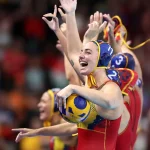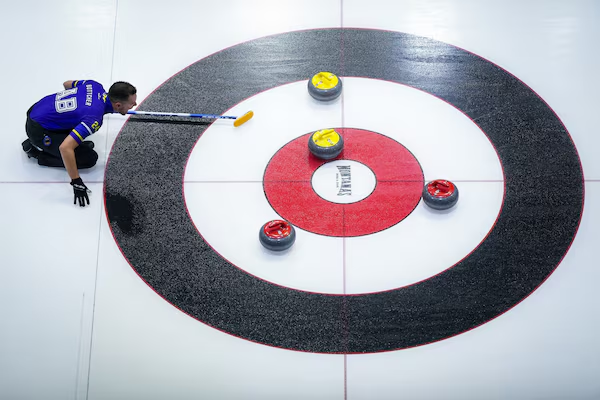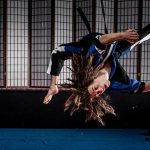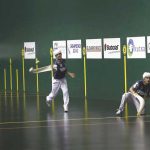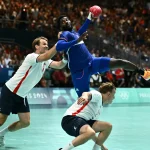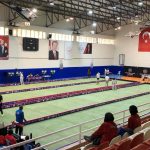Curling is a team sport played on a rectangular sheet of ice, where two teams of four players each take turns sliding heavy, polished granite stones (called rocks or stones) toward a circular target area known as the house.
Why is Curling Popular in the Global Sports Market?
Curling’s popularity in the global sports market stems from several factors:
- Olympic Exposure: Curling’s inclusion in the Winter Olympics since 1998 has significantly boosted its international profile, attracting new fans and players, particularly after high-profile moments like Team USA’s gold medal in 2018 or Team GB’s successes in 2022. The Olympics drive spikes in interest, with research indicating curling has seen the largest surge in Google searches among Olympic sports over the last decade.
- Accessibility and Inclusivity: Curling is accessible to a wide range of ages and abilities, from young children to seniors, and includes adaptive formats like wheelchair curling. Its low physical impact and emphasis on strategy make it appealing to diverse groups, including families and recreational players.
- Global Expansion: Historically dominated by Canada, Scotland, and Nordic countries, curling has grown in regions like the United States, Japan, China, and South Korea, fueled by Olympic success and new facilities. For example, China’s bronze in 2010 and Japan’s podium finish in 2018 marked Asia’s rising presence. Indoor, year-round curling facilities in warmer climates have further expanded its reach.
- Community and Social Appeal: Curling fosters a strong sense of community through curling clubs, which serve as social hubs. The “spirit of curling” emphasizes sportsmanship, with players often socializing post-game. This welcoming culture attracts newcomers and retains participants.
- Media and Fan Engagement: Curling’s strategic depth and quirky appeal (e.g., sweeping brooms) make it engaging on TV and social media. Posts on X highlight its charm, with one calling it a “billion-dollar opportunity” due to its unique fan base. The sport’s visibility during the Olympics, combined with growing digital streaming, enhances its market presence.
- Equipment Market Growth: The curling equipment market, valued at $564.4 million in 2024 and projected to reach $645.4 million by 2030 (2.3% CAGR), reflects rising participation. Innovations like carbon fiber brooms and advanced shoes drive demand among both recreational and competitive players.
Despite its niche status compared to soccer or basketball, curling’s steady growth in participation and market value—supported by a global sports industry worth $2.65 trillion—underscores its appeal as a unique, inclusive sport.
Important Global Curling Events
Key international curling events elevate the sport’s profile and provide platforms for athletes to shine:
- Winter Olympic Games: Held every four years, curling has been a medal sport since 1998, with men’s, women’s, and mixed doubles events. Canada leads in medals, followed by Sweden and Great Britain. The 2018 introduction of mixed doubles broadened its appeal.
- World Curling Championships: Organized annually by the World Curling Federation, these championships feature men’s, women’s, mixed doubles, and wheelchair events. Canada, Sweden, and Switzerland dominate, with the event serving as a critical stage for top teams.
- World Junior Curling Championships: This event showcases young talent, with winners often progressing to senior-level success. It’s a key development platform for countries like Canada and Scotland.
- World Mixed Doubles Curling Championship: A fast-paced format with one male and one female player per team, this event is a qualification pathway for the Olympics. Switzerland has excelled here.
- World Wheelchair Curling Championship: Promoting inclusivity, this event highlights adaptive athletes and has roots in the Paralympic Winter Games.
- Canadian Curling Pre-Trials (“Road to the Roar”): A qualifier for the Canadian Olympic Curling Trials, this event showcases Canada’s deep talent pool.
- Grand Slam of Curling: A series of elite tournaments in Canada, it attracts top global teams and offers significant prize money, boosting the sport’s professionalization.
These events, particularly the Olympics and World Championships, drive media coverage and fan interest, contributing to curling’s global market growth.
How to Get Started in Curling and Become Great
Getting Started (Young or Old)
- Find a Curling Club: Most curlers begin at local clubs, which offer learn-to-curl sessions, equipment rentals, and beginner leagues. The World Curling Federation and national bodies like USA Curling or Curling Canada list clubs (e.g., 185 clubs in the U.S. with 23,500 curlers). Clubs are welcoming, often providing brooms and sliders for novices.
- Learn the Basics: Beginners start with introductory clinics, learning delivery (sliding from the hack), sweeping, and basic strategy. Many clubs offer programs for kids, adults, and seniors, with adaptive options for wheelchair users.
- Equipment: Minimal gear is needed initially. Clubs provide stones, but players may need curling shoes (with a slider sole for delivery) and a broom. Entry-level shoes cost $100–$200, and brooms range from $50–$150. Comfortable, stretchy clothing is recommended.
- Join Leagues or Programs: Recreational leagues or youth programs, like Canada’s Junior Curling Championships, help beginners gain experience. Social play builds skills and community ties.
- Watch and Learn: Observing Olympic or Grand Slam events on TV or streaming platforms (e.g., NBC Olympics, TSN) helps beginners understand strategy. Online resources from the World Curling Federation offer tutorials.
Becoming Great
To excel in curling, athletes—young or old—must focus on skill development, physical and mental preparation, and competitive experience:
- Master Technique:
- Delivery: Practice consistent stone release and balance in the hack. Biomechanical studies show that angular joint velocities and range of motion are critical for precise stone placement.
- Sweeping: Develop strength and timing to influence stone trajectory. Sweeping requires endurance and coordination, as it can alter a stone’s path significantly.
- Strategy: Learn to read the ice and anticipate opponents’ moves. Elite curlers study game theory, akin to chess, to make tactical decisions (e.g., blanking an end to retain the hammer).
- Physical Training:
- Core and Balance: Curling demands trunk stability and motor control, especially for wheelchair athletes. Exercises like planks, yoga, or Pilates improve balance for delivery.
- Endurance and Strength: Sweeping is physically taxing, requiring cardiovascular fitness and upper-body strength. Training programs often include interval workouts and resistance exercises.
- Flexibility: Stretchy pants and dynamic stretching aid the low, sliding delivery position
- Mental Preparation:
- Psychological Skills: Studies show that psychological training (e.g., self-talk, imagery, and focus exercises) enhances performance under pressure. Elite curlers use routines to manage anxiety and maintain focus.
- Team Dynamics: Communication and interpersonal skills are vital, as curling relies on team synergy. Training in self-management and positive relationships boosts competitiveness
- Competitive Experience:
- Local and Regional Events: Progress from club leagues to regional tournaments, such as the Canadian Junior Championships or U.S. College Curling Nationals, to gain competitive experience.
- High-Performance Programs: Top curlers join national programs (e.g., USA Curling’s high-performance program) that offer coaching, sports science support, and team formation. These programs prioritize athletes with potential for Olympic or World Championship success.)
- International Exposure: Compete in World Junior Championships or Grand Slam events to face top global teams, building resilience and adaptability.
- Coaching and Mentorship: Work with experienced coaches to refine technique and strategy. Many Olympic medalists, like Canada’s Carolyn McRorie, mentor young curlers, sharing insights from high-level competition.
- Adapt to Innovations: Stay updated on equipment advancements (e.g., new broom heads or shoe designs) and ice-making technologies, which can affect gameplay. The 2015 “broomgate” controversy highlighted how equipment impacts skill, so understanding gear is key
- Inclusivity for All Ages: Young athletes can start in junior programs as early as age 8, while older athletes (even in their 50s or 60s) can excel in recreational or senior leagues. Wheelchair curling offers opportunities for adaptive athletes, with training focusing on trunk control and stone release.)
Path to Greatness
- Youth: Start in junior leagues, aim for national junior championships, and transition to senior events. Canada’s pipeline has produced Olympic champions from junior ranks
- Adults/Seniors: Join competitive club teams, enter regional qualifiers, and target events like the Canadian Pre-Trials. Consistent practice and mental toughness are critical.
- Wheelchair Athletes: Engage in specialized programs through national federations, focusing on adaptive techniques and psychological training.
- Commitment: Train 3–5 times weekly, balancing on-ice practice with off-ice fitness and mental conditioning. Elite curlers dedicate years to mastering the sport’s nuances.
Conclusion
Curling’s global popularity is driven by its Olympic spotlight, accessibility, and unique blend of strategy and sociability, carving a niche in the $2.65 trillion sports market. Major events like the Olympics and World Championships showcase its competitive appeal, while grassroots clubs fuel participation. Aspiring curlers, young or old, can start at local clubs, progress through structured training, and leverage psychological and physical preparation to achieve greatness. With growing facilities and media exposure, curling offers a welcoming path for anyone to become a skilled athlete in this “roaring game.”



